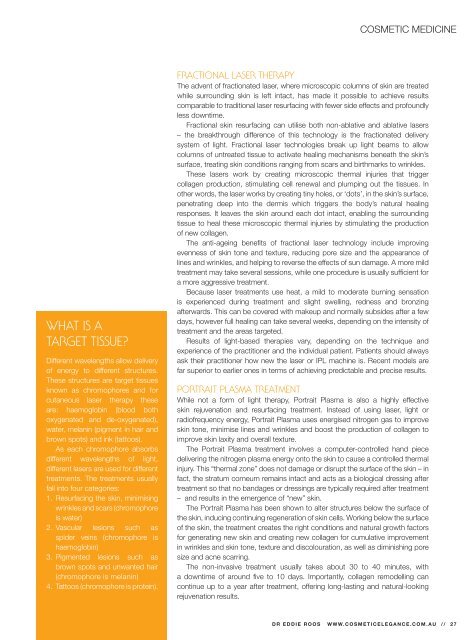Create successful ePaper yourself
Turn your PDF publications into a flip-book with our unique Google optimized e-Paper software.
COSMETIC MEDICINE<br />
WHAT IS A<br />
TARGET TISSUE?<br />
Different wavelengths allow delivery<br />
of energy to different structures.<br />
These structures are target tissues<br />
known as chromophores and for<br />
cutaneous laser therapy these<br />
are: haemoglobin (blood both<br />
oxygenated and de-oxygenated),<br />
water, melanin (pigment in hair and<br />
brown spots) and ink (tattoos).<br />
As each chromophore absorbs<br />
different wavelengths of light,<br />
different lasers are used for different<br />
treatments. The treatments usually<br />
fall into four categories:<br />
1. Resurfacing the skin, minimising<br />
wrinkles and scars (chromophore<br />
is water)<br />
2. Vascular lesions such as<br />
spider veins (chromophore is<br />
haemoglobin)<br />
3. Pigmented lesions such as<br />
brown spots and unwanted hair<br />
(chromophore is melanin)<br />
4. Tattoos (chromophore is protein).<br />
FRACTIONAL LASER THERAPY<br />
The advent of fractionated laser, where microscopic columns of skin are treated<br />
while surrounding skin is left intact, has made it possible to achieve results<br />
comparable to traditional laser resurfacing with fewer side effects and profoundly<br />
less downtime.<br />
Fractional skin resurfacing can utilise both non-ablative and ablative lasers<br />
– the breakthrough difference of this technology is the fractionated delivery<br />
system of light. Fractional laser technologies break up light beams to allow<br />
columns of untreated tissue to activate healing mechanisms beneath the skin’s<br />
surface, treating skin conditions ranging from scars and birthmarks to wrinkles.<br />
These lasers work <strong>by</strong> creating microscopic thermal injuries that trigger<br />
collagen production, stimulating cell renewal and plumping out the tissues. In<br />
other words, the laser works <strong>by</strong> creating tiny holes, or ‘dots’, in the skin’s surface,<br />
penetrating deep into the dermis which triggers the body’s natural healing<br />
responses. It leaves the skin around each dot intact, enabling the surrounding<br />
tissue to heal these microscopic thermal injuries <strong>by</strong> stimulating the production<br />
of new collagen.<br />
The anti-ageing benefits of fractional laser technology include improving<br />
evenness of skin tone and texture, reducing pore size and the appearance of<br />
lines and wrinkles, and helping to reverse the effects of sun damage. A more mild<br />
treatment may take several sessions, while one procedure is usually sufficient for<br />
a more aggressive treatment.<br />
Because laser treatments use heat, a mild to moderate burning sensation<br />
is experienced during treatment and slight swelling, redness and bronzing<br />
afterwards. This can be covered with makeup and normally subsides after a few<br />
days, however full healing can take several weeks, depending on the intensity of<br />
treatment and the areas targeted.<br />
Results of light-based therapies vary, depending on the technique and<br />
experience of the practitioner and the individual patient. Patients should always<br />
ask their practitioner how new the laser or IPL machine is. Recent models are<br />
far superior to earlier ones in terms of achieving predictable and precise results.<br />
PORTRAIT PLASMA TREATMENT<br />
While not a form of light therapy, Portrait Plasma is also a highly effective<br />
skin rejuvenation and resurfacing treatment. Instead of using laser, light or<br />
radiofrequency energy, Portrait Plasma uses energised nitrogen gas to improve<br />
skin tone, minimise lines and wrinkles and boost the production of collagen to<br />
improve skin laxity and overall texture.<br />
The Portrait Plasma treatment involves a computer-controlled hand piece<br />
delivering the nitrogen plasma energy onto the skin to cause a controlled thermal<br />
injury. This “thermal zone” does not damage or disrupt the surface of the skin – in<br />
fact, the stratum corneum remains intact and acts as a biological dressing after<br />
treatment so that no bandages or dressings are typically required after treatment<br />
– and results in the emergence of “new” skin.<br />
The Portrait Plasma has been shown to alter structures below the surface of<br />
the skin, inducing continuing regeneration of skin cells. Working below the surface<br />
of the skin, the treatment creates the right conditions and natural growth factors<br />
for generating new skin and creating new collagen for cumulative improvement<br />
in wrinkles and skin tone, texture and discolouration, as well as diminishing pore<br />
size and acne scarring.<br />
The non-invasive treatment usually takes about 30 to 40 minutes, with<br />
a downtime of around five to 10 days. Importantly, collagen remodelling can<br />
continue up to a year after treatment, offering long-lasting and natural-looking<br />
rejuvenation results.<br />
DR EDDIE ROOS WWW.COSMETICELEGANCE.COM.AU // 27


















